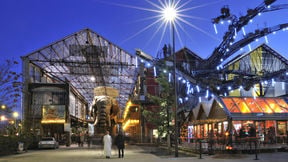Public defence in Design, Architect M.Sc. Hella Hernberg

When
Where
Event language(s)
Architect M.Sc. Hella Hernberg will defend the thesis " Architects as ‘Mediators’: Socio-political roles in mediating the ‘temporary use’ of vacant spaces" on 3 June 2022 at 12:00 in Aalto University School of Arts, Design and Architecture, Department of Design, in lecture hall H304, Otakaari 1, Espoo, and online in Zoom.
Opponent: Prof. Liesbeth Huybrechts, Hasselt University, Belgium
Custos: Prof. Mikko Jalas, Aalto University School of Arts, Design and Architecture, Department of Design
The public defence will be organized via remote technology. Follow defence: https://aalto.zoom.us/j/64237410890
Zoom Quick Guide: https://www.aalto.fi/en/services/zoom-quick-guide
Thesis available for public display at: https://aaltodoc.aalto.fi/doc_public/eonly/riiputus/
Doctoral theses in the School of Arts, Design and Architecture: https://aaltodoc.aalto.fi/handle/123456789/54
Press release:
Offices, schools, hospitals, industrial properties and other spaces are constantly left vacant as part of urban change processes. The temporary use of vacant spaces is recognised as one approach for advancing resource-efficient, adaptable and inclusive urban development. In practice, temporary use often faces structural barriers and tensions between different actors and interests.
The doctoral thesis by architect Hella Hernberg, “Architects as ‘Mediators’: Socio-political roles in mediating the ‘temporary use’ of vacant spaces”, investigates the roles of actors mediating temporary use. Although mediation is recognised as necessary in enabling and advancing temporary use, there is scant academic research on the topic.
The thesis positions mediation as an emerging domain of work for architects, who often engage in temporary use. One example is Hernberg’s own experience as an architect in this field.
The research integrates knowledge from the fields of temporary use, architecture, participatory design and urban sustainability transitions and investigates mediation in practice from two methodological perspectives: A practice-based study focuses on Hernberg’s own work in a temporary use project in Espoo, Finland, and a qualitative interview study broadens the perspective to five mediators’ work in four European cities.
The findings of the thesis demonstrate mediation work as essentially social and political, even if it occurs in a spatial context. As a key finding, Hernberg articulates three roles for mediators: they broker the collaboration and partnerships between actors, negotiate the structural conditions and build capabilities for temporary use. Such roles demonstrate the breadth and complexity of mediation work. It is not limited to rental operations but instead aims at questioning and changing the prevalent conventions and premises in real-estate management and development as well as urban planning and governance.
The three mediator roles also highlight the transformation of professional work in architecture and design fields. This calls attention to the need for multidisciplinary training and competencies in these fields, particularly when responding to the urgent sustainability challenges of today. Therefore, the thesis provides useful knowledge for municipalities and practitioners on resource-efficient, inclusive and adaptable urban development.
Contact information of doctoral candidate:
|
|
|
|
Mobile |
+358503779703 |
- Published:
- Updated: